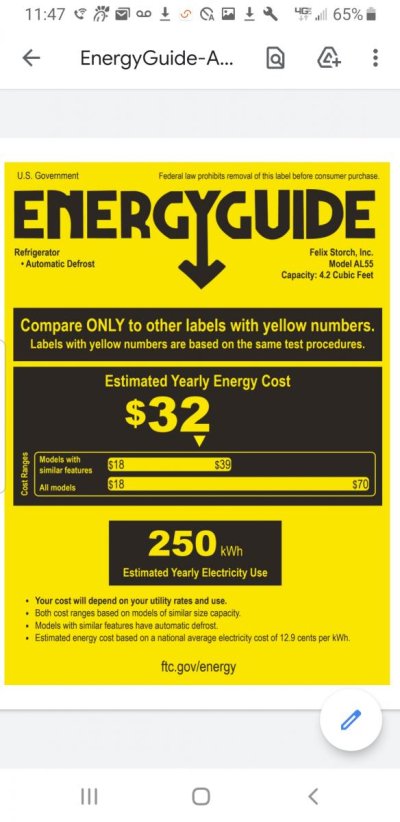catalinajack
Guru
You're wrong about the Energy Guide. It's not a calculation based on assumptions. Its an actual test under set standards. Here's a link to the government regulation on the test:
https://www.google.com/url?sa=t&sou...AQFnoECB4QAQ&usg=AOvVaw2KStj5uBxrl4_sfrPZguD2
So you're saying a 120 VAC appliance run off a pure sine wave inverter consumes 300% of the electricity of when its plugged into shore power? The refrigerator consumes no more electricity on a pure sine wave inverter. There's no difference as far as what the refrigerator is consuming. The inverter consumes a little more electricity to do the conversion. The average conversion cost is under 10%.
Please show me your math or link an explanation of what your claiming.
Ted
No, Ted, that is not what I said, not even close. Of course, when on AC the fridge consumes exactly the same number of watts when on shore power or an inverter except for one Itty bitty thing, the 13-15% inversion loss factor. And, to my way of thinking, what matters is not the yellow sticker or its methodology, it is the MANUFACTURER'S specs on the power consumption of its compressor motor. And, by the way, please explain how any estimate, the yellow sticker, can be made without an assumption, you know, like how many hours a day will the average fridge run.
You want numbers? Here are some. These are based on a brand new (efficient?) Summit 4.2 c.f. 120VAC fridge as compared to a Vitrifrigo 4.2 model combo AC/DC assuming a duty cycle of 12 hours per day. Adjust as you will for a higher or lesser duty cycle, the assumption part of the equation. The comparison must be done in watts according to Ohm's Law, the only measure that means anything, not the yellow sticker, not somebody's plug-in meter.
The Summit compressor draws 1.0 amp AC.
The Vitrifrigo draws .57 amp AC.
The Vitrifrigo draws 3.75 amp DC.
Summit - 1.0 amp x 120V = 120 watts
Vitrifrigo AC - .57 amp x 120V = 68.4 watts
Vitrifrigo DC - 3.78 amp x 12V = 45 watts
So, assuming a 12-hour per day duty cycle, the Summit uses 1,440 watts while the Vitrifrigo on DC uses 540 watts. On inverter, the Summit will use 1,627 watts factoring in the inversion inefficiency.
As you can see, the marine fridge is far more efficient than the domestic Summit fridge and, yes, when compared to straight DC operation, the number is indeed almost exactly 300%. As requested, I have included a link, a link to the Fluke website which explains Ohm's Law in detail. Ted, there is no escaping the principles of Ohm's Law.
https://www.fluke.com/en-us/learn/blog/electrical/what-is-ohms-law
Now, if you have a large battery bank and you don't care about these numbers, AKA facts, that's fine. If your user profile is such that you marina hop or anchor infrequently, these facts do not matter much. For for some boaters, it is important. None of this considers initial capital cost and is irrelevant to the technical aspects of this discussion. However, I fully recognize that capital cost is relevant in all boating choices. None of this is to say that I would never consider using a domestic fridge on a boat. It all depends.
To bring my calculations to the yellow sticker format ($/year) assuming a cost of $.15/kwh:
Summit - (1,440/day x 365 days x .15) / 1000 = $78.84. Add 13% when on inverter.
Vitrifrigo DC - (540/day x 365 days x .15) / 1000 = $29.57
Obviously, the cost difference may be insignificant but, for some, the amp-hour consumption difference is meaningful. And that, folks, was the one and only point I was trying to make, perhaps ill-explained, but, still, the only point.
Summit - 120 amphours/day
Vitrifrigo - 45 amphours/day
Scale up for larger fridges. One last comment on the yellow sticker. That test would have been conducted in an assumed home environment, that is, in a room that would be at around a constant 70 degrees. Our fridges generally live in a much more demanding environment which requires longer daily duty cycles. Who can argue that any electrical appliance uses twice as much juice when run twice as long. Do your own calculations based on your own environment. The sticker is merely an estimate based on a set of assumptions. It can be no less.
Last edited:



